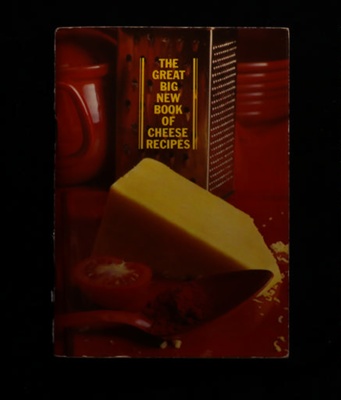Name/TitleRecipe Book
About this objectSmall book "The Great Big New Book of Cheese Recipes"
Issued by The Cheese Bureau, a marketing body who promoted the consumption of dairy products as rationing ended.
Used by the Longe Family of Abbots Hall
Glossy cover shows a wedge of cheese
Richard Hall, Research Volunteer:
‘The Great Big New Book of Cheese Recipes’ contains lots of helpful tips on how to use cheese in everyday cooking including recipe ideas for: filler dishes; pastry; cheese sauces; cheese with eggs; salads; snacks, together with nutritional information and some facts about cheese.
The Cheese Bureau, was set up in 1955, as a representative body for UK and Commonwealth cheese producers. Their dominant interest was in Cheddar and Cheshire cheeses which, at that time, accounted for roughly 80% of cheese sales. Its members included the New Zealand Dairy Production and Marketing Board, Australian Dairy Produce Board, the Milk Marketing Board of England, Wales, Scotland, Ontario and Northern Ireland and the Cheese Board of Eire.
The Cheese Bureau acted solely as a promotional force, producing promotional pamphlets and recipe books such as the one in our collection. Although a force for the promotion of home grown products, the Cheese Bureau was only in existence for 17 years, its closure coinciding with our entry into the European Union (EU), or Common Market, on 1st January 1973 . We might surmise, that when Britain joined the EU, any organisations whose sole aim was to promote British products, would no longer be considered politically appropriate.
Although difficult to evidence, it has been suggested that cheese making in Britain began in pre-Roman times . It is likely however that cheese making was either a skill imported to this country from the continent or otherwise discovered by accident, when milk was left to curdle.
Cheese is made by removing the excess water (‘whey’) from cows milk, although goats or even buffalo milk can be used. The process uses a gentle heat to establish a very loose jelly like ‘curd’. ‘Rennet’, which is an animal based enzyme, and starter cultures are added to the curd to firm it before adding salt to the mixture. It is then cut and pressed into shape, which process removes any excess water. The drier and harder the cheese becomes during this process, the longer it tends to keep. The final product is stored for 12 to 15 months in a cool room, a process known as ‘maturing’ before being eaten.
Medium and MaterialsMaterials: Card, paper and metal staples (the binding)
Measurements108mm x 154mm x 5mm
Object numberSTMEA:2009-4
Copyright Licence![]() Attribution - Non-commercial (cc)
Attribution - Non-commercial (cc)



